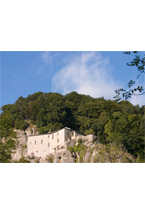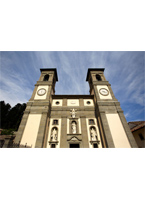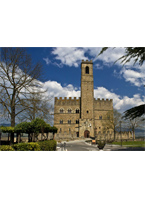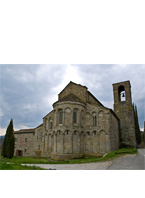|
|
The Casentino. what to see
Rich in history, the Casentino is an extraordinary marriage of natural beauty and artistic masterpieces, a valley where civil and religious buildings bear witness to an exuberant and flourishing civilisation during the Middle Ages.
|
|
|
|
CHIUSI DELLA VERNA, CHITIGNANO
From Bibbiena the road leads on towards the Franciscan Shrine of La Verna and on the way you can enjoy one of the Casentino’s greatest riches, the forests. The “Parco Naturale delle Foreste Casentinesi, Monte Falterona, Campigna” was established on 12 July 1993 in order to preserve this wonderful natural environment. With an area of 36,000 hectares, the park extends from just north of Chiusi della Verna to Emilia-Romagna. Driving through the peace and silence of the forest, you reach La Verna, well known for its natural and artistic beauty but, above all, as a place to seek St Francis of Assisi in pilgrimage. In 1213, the saint in all his poverty was given this part of the mountain by Count Orlando Cattani of Chiusi della Verna and, when he arrived here with his companions for the first time in 1214, there were no buildings to shelter them, save a hut made from wood and leaves. However, between 1216 and 1218, the small Chiesetta di Santa Maria degli Angeli had already been built. The building with its portico that you can see today results from a series of reconstructions made necessary, as in the rest of the monastery, by the rigours of the severe winter climate. The church has a single nave and possesses valuable terracotta works from the Della Robbia workshop depicting the Nativity and the Deposition from the Cross, while the Assumption of the Blessed Virgin on the altar is by Andrea della Robbia from about 1490.
In front of this chapel, you will see the old access to the monastery with the ancient road to the village of Beccia and, from here, you go into the Basilica of Our Lady of the Assumption, started after 1348 to fulfil the wishes of the Tarlati Counts of Pietramala, but which was not completed until 1509 when the Florentine corporation of cloth workers, Arte della Lana di Firenze, intervened. The church consists of a single nave with four cross-vaulted bays. It is full of artworks and reliquaries which recall moments in the life of St Francis when he lived here, on the sacred mount of La Verna. Most importantly, there are two shrines in the shape of a baldacchino. The Nativity, on the left, was made in glazed terracotta in 1479 by Andrea della Robbia, the celebrated plastic artist from Florence. He also made the other shrine depicting the Annunciation, in 1476, and Our Lady of Refuge, from 1515-1520, found on the first altar on the right. This work shows he was assisted by other artists from his workshop, whereas in the chapel of the same name, the Ascension, was entirely made by the Master in 1490. The “Cappella delle Reliquie”, or relics, has the important items linking St Francis with La Verna: the table-cloth, the bowl and the glass prepared for him by Count Orlando Cattani, the relic of blood and, in a climate-controlled display case, the Saint’s cowl.
From outside the basilica, you can walk along the Corridor of the Stigmata decorated with frescoes depicting Episodes in the Saint’s Life, painted for the most part by the Florentine artist Baccio Maria Bacci between 1929 and 1963. A number of wonderful places open off from this Corridor, and among these is the cavern where you can see the so-called “bed of St Francis”. After this you pass the entrance to the Hermitage, some other chapels, and reach the Chapel of the Stigmata constructed in 1263 under the direction of Count Simone da Battifolle upon the site where St Francis received, from a seraph, Christ’s wounds on his own body. To recall this event, on the altar there is a glazed terracotta depicting the Crucifixion made by Andrea della Robbia in 1481. There are a good number of places where you can feel the presence of the Saint and his friars and, no less, the care given to the artworks donated by devout followers and found in the sacristy, in the old guest-quarters and in the cloisters, and also in the Museo della Verna where there are a number of very precious paintings even coming from other Franciscan foundations. There ia an Annunciation by Guillaume de Marcillat and a magnificent late 15th-century Crucifix, but above all there are valuable sacred hangings and objects which give you an idea of the life of the Franciscan community over the centuries.
Close to the Museum is the Cappella dell’Adorazione where some detached frescoes are kept. They were painted around 1499 in the Cappella del Beato Giovanni by Domenico Pecori pupil of the painter and architect Bartolomeo della Gatta who, after Piero della Francesca had left the district, was the most important artist working in Arezzo in the second half of the 15th century.
|
 |
|
|
CASTEL S.NICCOLO', MONTEMIGNAIO
Going from Poppi towards Castel San Niccolò, you come to the plain of CAMPALDINO on the right. It was here that, on 11 June 1289, the Battle of Campaldino took place in which the forces of Arezzo were defeated by the Florentine army. This was the moment when fortune smiled on Florence’s dream of expanding through Tuscany, and the dream continued until the 16th century. In front of the battlefield stands the Chiesa di Certomondo which was constructed by the Counts Guidi, together with the adjoining but now disused monastery, in 1262, to commemorate the Ghibelline victory in the Battle of Montaperti in which Siena defeated Florence. The church, with a single nave and trussed ceiling, has an Annunciation by Neri di Bicci from 1466 on the left-hand presbytery wall. Outside, there is a beautiful 15th-century cloister, part of which is closed.
Proceeding west, you reach Montemignaio , a village which is dominated by the imposing Castel Leone which Frederick Barbarossa presented to the Counts Guidi. In the village, you will see the Pieve di Santa Maria Assunta, which dates back to the year 1000. The nave is separated from the two aisles by columns with splendid capitals and conserves valuable works of art, including a painting from the school of Ghirlandaio and a terracotta in the della Robbia style.
|
|
|
|
CASTELFOCOGNANO,TALLA, BIBBIENA
Returning from Castel Focognano to Rassina and travelling once again on the road towards the north, you arrive at Bibbiena, a township which also belonged to the powerful Tarlati family in the Middle Ages and which, after various ownership changes, eventually passed to the dominion of Florence. You can see the 16th-century Palazzo of the Dovizi family into which Cardinal Bernardo Dovizi was born. A distinguished man of letters, he was known as “il Bibbiena”, and became the secretary to the Medici Pope Leo X and friend to the artist Raphael. Opposite this noble residence stands the 15th-century Chiesa di San Lorenzo which was restored during the second decade of the 20th century. The most important of the valuable works of art are terracottas by Andrea and Giovanni della Robbbia, as well as a small but beautiful cloister. Also worth looking at is the Chiesa dei Santi Ippolito e Donato, in ancient times the chapel of the Tarlati citadel. It dates back to the 12th century but was reconstructed in later years, above all in the 14th and 15th centuries.
With a single nave and trussed ceiling, the church possesses a 1435 Triptych on the high altar by Bicci di Lorenzo, a Madonna with Child and Angels by Arcangelo di Cola da Camerino, and a 14th-century painted Cross ascribed to the Maestro di San Polo in Rosso. In the environs of Bibbiena stands the Santuario della Madonna del Sasso, one of the loveliest examples of Renaissance architecture in the Casentino. Tradition has it that the Blessed Virgin appeared on a massive rock here, on a number of occasions, and subsequently a church was built on this rock. It was reconstructed between 1468 and 1507 by Giuliano da Maiano. Worth looking at is the Shrine with a della Robbia-style frieze, in which there is a fresco of the Madonna and Child with Two Angels by Bicci di Lorenzo, and a Nativity of the Blessed Virgin with Saints by Jacopo Ligozzi, signed and dated 1607. In the richly-decorated crypt, you can see a Madonna and Child between St Bartholomew and St Matthew from around 1536, by Giovann’Antonio Lappoli, one of Arezzo’s most important artists of the 16th century.
|
|
|
|
CAMALDOLI
From the sacred mountain of La Verna, you continue driving through the forests of the Natural Park until you reach another place of great cultural and artistic significance, the monastery of Camaldoli . The name comes from Count Conte Maldolo, hence Ca’ Maldoli, who was feudal lord to the Bishop of Arezzo. In the early part of the year 1000, he donated this vast territory to St Romuald who, in his reformation of the Rule of St Benedict, founded the Camaldolese order in these lands in 1012. He constructed the original part of the hermitage and, subsequently, the guest-quarters to receive pilgrims. Over the centuries, the complex of buildings saw a good many ups and downs and, in the 15th century, was also a cultural centre. It comprises a number of structures, the Monastery, the Church and the Guest-quarters. In the latter, there is a beautiful cloister from the 11th-12th centuries, known as Maldolo’s cloister, and also another from the 15th century. Dedicated to St Donatus and St Hilarian, the church was constructed on a previous building from the year 1000 and dates from 1509-1524. The Baroque interior is the result of an 18th-century reconstruction and you will find five panels painted for this church by Giorgio Vasari depicting the Madonna and Child with St John Baptist and St Girolamus, the Nativity, the Deposition from the Cross and Two Episodes from the life of St Hilarian. From the church, you can have access to the cloister and the 16th-century pharmacy. The monastery is still to this day inhabited by monks and retains its 17th-century refectory with decorations by important artists of the day. Go now to the Hermitage, situated in a rather splendid position. This was the original site of the order founded by St Romuald. Women are not permitted to enter the cells where the hermit monks live, but you can visit the Library and the Chiesa di San Salvatore which was consecrated in 1027 but reconstructed during the 18th century. From Camaldoli, you can take a number of escursions, and a walk from the Hermitage into the foresta della Lama along the Scalandrini track is especially recommended. There are, however, so many ways for you to enjoy this place where nature in all its splendour is one with such enduring expressions of devotion.
|
 |
|
|
GIOVI, CAPOLONA E SUBBIANO
You take the road from Arezzo towards the village of Giovi where you will find the Pieve a Siétina, dedicated to St Mary Magdalen. Records show that this church, which has been extensively reconstructed over the years, has been here since the 11th century and was once under the patronage of the Bacci family of Arezzo, the same family who commissioned Piero della Francesca.
Inside the church, with its nave separated from the two aisles by pillars, there are some interesting frescoes by local artists ranging from the late 14th century to the end of the 15th. There is a Madonna and Child Enthroned, an Annunciation, and two figures, St Bernardine and St Anthony, all painted perhaps around 1490 and ascribed to the circle of Lorentino d’Andrea, the most prolific of the painters assisting Piero della Francesca in the Cycle of the True Cross in San Francesco, Arezzo. And it is to the workshop of Lorentino, and perhaps also to his son and assistant, Niccolò, that we can attribute the late 15th-century fresco cycle decorating the chapel of San Giuseppe in the Castello della Fioraia, the ancient manor house built near Castelnuovo di Subbiano. This building was originally a small but powerful stronghold, from which the tower remains, and it was transformed into a manorial residence by Simone della Fioraia. During this reconstruction phase, perhaps, frescoes were commissioned for the small chapel depicting the Annunciation, the Nativity, the Adoration of the Magi, and St Anthony Abbot with St Roch, St Sebastian and St Lucy.
|
|
|
|
POPPI
If you head south from Camaldoli, you will reach Poppi, the township that was the principal residence of the Guidi Counts in 1169. After these powerful feudal lords were defeated by the Florentines in 1440 in the Battle of Anghiari, Poppi passed under the dominion of the Republic of Florence. The grandiose Palazzo Pretorio is of special importance. Once the Castle of the Guidi family, it was built around 1100, almost completely reconstructed in 1274 and enlarged in 1291, possibly by Arnolfo di Cambio. It was then heavily restored in the 20th century. The tower rises above the central core with its Guelphic crenellations and, to accede to the interior courtyard, you must cross the moat. From here you can go to the chambers located on the 1st and 2nd storey. The priceless archives and library housed in this building are invaluable to scholars of medieval history. In the township and not far from the castle stands the Chiesa di San Fedele, one of the most important in the Casentino. Built between 1185 and 1195, its bell tower incorporates a tower that was part of the town walls. With its brick-coloured façade, the church has the form of a Latin cross with a single nave and trussed ceiling. It is richly decorated with works by mainly 17th-century Florentine artists.
|
 |
|
|
ROMENA, PRATOVECCHIO, STIA
Going back now to Castel San Niccolò and proceeding towards Pratovecchio, you visit what is perhaps the most important of the numerous Romanesque pievi in the Casentino, the Pieve di San Pietro a Romena. Dating back to the 8th-9th centuries, its present-day appearance comes from the mid-12th century. The exterior has undergone a number of vicissitudes, including the destruction of the façade in 1678 and the earthquake damage of 1729. Despite this, and taken as a whole, you can still appreciate the apse with its two orders of arches and the bell tower. The interior plan is of a basilica with a nave and two aisles separated by columns with superb capitals. Not far from the church is the Castello di Romena with impressive ruins. Constructed by the Counts Guidi, it eventually passed into the hands of the Florentines. A truly splendid view of the whole Casentino can be had from the ancient manor house. From Romena, you reach Pratovecchio and Stia. Pratovecchio, as the arcaded piazzas testify, was the ancient market attached to the castle of Romena. Worth seeing is the Church of Santa Maria at Poppiena. Stia is an important textile centre and the cloth which is still produced here is called “casentino”. The ancient pieve here has now become the parish church of Santa Maria Assunta with a medieval tower that serves as the bell tower. Inside, there is a triptych by Bicci di Lorenzo, from 1414, and a Madonna and Child by Andrea della Robbia. From here, you do not have a long drive to reach the Castello di Porciano, one of the first residences of the Counts Guidi.
|
 |
|
|
Copyright © 2008 ArezzoTurismo p.i. 01756610513
|
|
|

